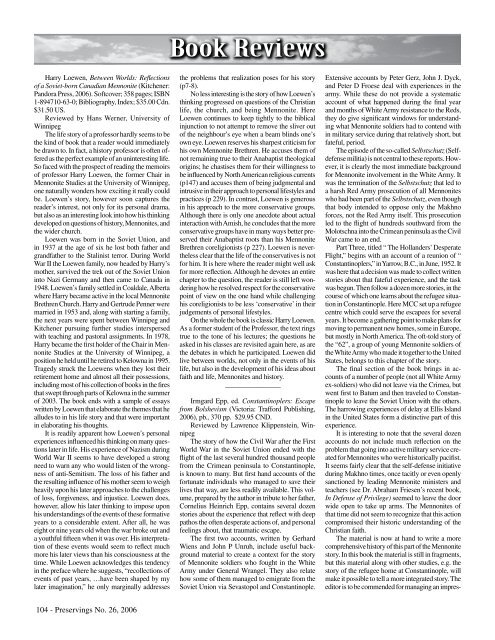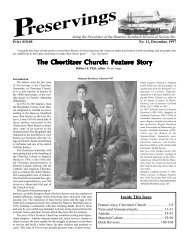Preservings $20 Issue No. 26, 2006 - Home at Plett Foundation
Preservings $20 Issue No. 26, 2006 - Home at Plett Foundation
Preservings $20 Issue No. 26, 2006 - Home at Plett Foundation
Create successful ePaper yourself
Turn your PDF publications into a flip-book with our unique Google optimized e-Paper software.
Book Reviews<br />
Harry Loewen, Between Worlds: Reflections<br />
of a Soviet-born Canadian Mennonite (Kitchener:<br />
Pandora Press, <strong>2006</strong>). Softcover; 358 pages; ISBN<br />
1-894710-63-0; Bibliography, Index; $35.00 Cdn.<br />
$31.50 US.<br />
Reviewed by Hans Werner, University of<br />
Winnipeg<br />
The life story of a professor hardly seems to be<br />
the kind of book th<strong>at</strong> a reader would immedi<strong>at</strong>ely<br />
be drawn to. In fact, a history professor is often offered<br />
as the perfect example of an uninteresting life.<br />
So faced with the prospect of reading the memoirs<br />
of professor Harry Loewen, the former Chair in<br />
Mennonite Studies <strong>at</strong> the University of Winnipeg,<br />
one n<strong>at</strong>urally wonders how exciting it really could<br />
be. Loewen’s story, however soon captures the<br />
reader’s interest, not only for its personal drama,<br />
but also as an interesting look into how his thinking<br />
developed on questions of history, Mennonites, and<br />
the wider church.<br />
Loewen was born in the Soviet Union, and<br />
in 1937 <strong>at</strong> the age of six he lost both f<strong>at</strong>her and<br />
grandf<strong>at</strong>her to the Stalinist terror. During World<br />
War II the Loewen family, now headed by Harry’s<br />
mother, survived the trek out of the Soviet Union<br />
into Nazi Germany and then came to Canada in<br />
1948. Loewen’s family settled in Coaldale, Alberta<br />
where Harry became active in the local Mennonite<br />
Brethren Church. Harry and Gertrude Penner were<br />
married in 1953 and, along with starting a family,<br />
the next years were spent between Winnipeg and<br />
Kitchener pursuing further studies interspersed<br />
with teaching and pastoral assignments. In 1978,<br />
Harry became the first holder of the Chair in Mennonite<br />
Studies <strong>at</strong> the University of Winnipeg, a<br />
position he held until he retired to Kelowna in 1995.<br />
Tragedy struck the Loewens when they lost their<br />
retirement home and almost all their possessions,<br />
including most of his collection of books in the fires<br />
th<strong>at</strong> swept through parts of Kelowna in the summer<br />
of 2003. The book ends with a sample of essays<br />
written by Loewen th<strong>at</strong> elabor<strong>at</strong>e the themes th<strong>at</strong> he<br />
alludes to in his life story and th<strong>at</strong> were important<br />
in elabor<strong>at</strong>ing his thoughts.<br />
It is readily apparent how Loewen’s personal<br />
experiences influenced his thinking on many questions<br />
l<strong>at</strong>er in life. His experience of Nazism during<br />
World War II seems to have developed a strong<br />
need to warn any who would listen of the wrongness<br />
of anti-Semitism. The loss of his f<strong>at</strong>her and<br />
the resulting influence of his mother seem to weigh<br />
heavily upon his l<strong>at</strong>er approaches to the challenges<br />
of loss, forgiveness, and injustice. Loewen does,<br />
however, allow his l<strong>at</strong>er thinking to impose upon<br />
his understandings of the events of these form<strong>at</strong>ive<br />
years to a considerable extent. After all, he was<br />
eight or nine years old when the war broke out and<br />
a youthful fifteen when it was over. His interpret<strong>at</strong>ion<br />
of these events would seem to reflect much<br />
more his l<strong>at</strong>er views than his consciousness <strong>at</strong> the<br />
time. While Loewen acknowledges this tendency<br />
in the preface where he suggests, “recollections of<br />
events of past years, …have been shaped by my<br />
l<strong>at</strong>er imagin<strong>at</strong>ion,” he only marginally addresses<br />
the problems th<strong>at</strong> realiz<strong>at</strong>ion poses for his story<br />
(p7-8).<br />
<strong>No</strong> less interesting is the story of how Loewen’s<br />
thinking progressed on questions of the Christian<br />
life, the church, and being Mennonite. Here<br />
Loewen continues to keep tightly to the biblical<br />
injunction to not <strong>at</strong>tempt to remove the sliver out<br />
of the neighbour’s eye when a beam blinds one’s<br />
own eye. Loewen reserves his sharpest criticism for<br />
his own Mennonite Brethren. He accuses them of<br />
not remaining true to their Anabaptist theological<br />
origins; he chastises them for their willingness to<br />
be influenced by <strong>No</strong>rth American religious currents<br />
(p147) and accuses them of being judgmental and<br />
intrusive in their approach to personal lifestyles and<br />
practices (p 229). In contrast, Loewen is generous<br />
in his approach to the more conserv<strong>at</strong>ive groups.<br />
Although there is only one anecdote about actual<br />
interaction with Amish, he concludes th<strong>at</strong> the more<br />
conserv<strong>at</strong>ive groups have in many ways better preserved<br />
their Anabaptist roots than his Mennonite<br />
Brethren coreligionists (p 227). Loewen is nevertheless<br />
clear th<strong>at</strong> the life of the conserv<strong>at</strong>ives is not<br />
for him. It is here where the reader might well ask<br />
for more reflection. Although he devotes an entire<br />
chapter to the question, the reader is still left wondering<br />
how he resolved respect for the conserv<strong>at</strong>ive<br />
point of view on the one hand while challenging<br />
his coreligionists to be less ‘conserv<strong>at</strong>ive’ in their<br />
judgements of personal lifestyles.<br />
On the whole the book is classic Harry Loewen.<br />
As a former student of the Professor, the text rings<br />
true to the tone of his lectures; the questions he<br />
asked in his classes are revisited again here, as are<br />
the deb<strong>at</strong>es in which he particip<strong>at</strong>ed. Loewen did<br />
live between worlds, not only in the events of his<br />
life, but also in the development of his ideas about<br />
faith and life, Mennonites and history.<br />
________________<br />
Irmgard Epp, ed. Constantinoplers: Escape<br />
from Bolshevism (Victoria: Trafford Publishing,<br />
<strong>2006</strong>), pb., 370 pp. $29.95 CND.<br />
Reviewed by Lawrence Klippenstein, Winnipeg<br />
The story of how the Civil War after the First<br />
World War in the Soviet Union ended with the<br />
flight of the last several hundred thousand people<br />
from the Crimean peninsula to Constantinople,<br />
is known to many. But first hand accounts of the<br />
fortun<strong>at</strong>e individuals who managed to save their<br />
lives th<strong>at</strong> way, are less readily available. This volume,<br />
prepared by the author in tribute to her f<strong>at</strong>her,<br />
Cornelius Heinrich Epp, contains several dozen<br />
stories about the experience th<strong>at</strong> reflect with deep<br />
p<strong>at</strong>hos the often desper<strong>at</strong>e actions of, and personal<br />
feelings about, th<strong>at</strong> traum<strong>at</strong>ic escape.<br />
The first two accounts, written by Gerhard<br />
Wiens and John P Unruh, include useful background<br />
m<strong>at</strong>erial to cre<strong>at</strong>e a context for the story<br />
of Mennonite soldiers who fought in the White<br />
Army under General Wrangel. They also rel<strong>at</strong>e<br />
how some of them managed to emigr<strong>at</strong>e from the<br />
Soviet Union via Sevastopol and Constantinople.<br />
Extensive accounts by Peter Gerz, John J. Dyck,<br />
and Peter D Froese deal with experiences in the<br />
army. While these do not provide a system<strong>at</strong>ic<br />
account of wh<strong>at</strong> happened during the final year<br />
and months of White Army resistance to the Reds,<br />
they do give significant windows for understanding<br />
wh<strong>at</strong> Mennonite soldiers had to contend with<br />
in military service during th<strong>at</strong> rel<strong>at</strong>ively short, but<br />
f<strong>at</strong>eful, period.<br />
The episode of the so-called Selbstschutz (Selfdefense<br />
militia) is not central to these reports. However,<br />
it is clearly the most immedi<strong>at</strong>e background<br />
for Mennonite involvement in the White Army. It<br />
was the termin<strong>at</strong>ion of the Selbstschutz th<strong>at</strong> led to<br />
a harsh Red Army prosecution of all Mennonites<br />
who had been part of the Selbstschutz, even though<br />
th<strong>at</strong> body intended to oppose only the Makhno<br />
forces, not the Red Army itself. This prosecution<br />
led to the flight of hundreds southward from the<br />
Molotschna into the Crimean peninsula as the Civil<br />
War came to an end.<br />
Part Three, titled “ The Hollanders’ Desper<strong>at</strong>e<br />
Flight,” begins with an account of a reunion of “<br />
Constantinoplers,” in Yarrow, B.C., in June, 1952. It<br />
was here th<strong>at</strong> a decision was made to collect written<br />
stories about th<strong>at</strong> f<strong>at</strong>eful experience, and the task<br />
was begun. Then follow a dozen more stories, in the<br />
course of which one learns about the refugee situ<strong>at</strong>ion<br />
in Constantinople. Here MCC set up a refugee<br />
centre which could serve the escapees for several<br />
years. It become a g<strong>at</strong>hering point to make plans for<br />
moving to permanent new homes, some in Europe,<br />
but mostly in <strong>No</strong>rth America. The oft-told story of<br />
the “62”, a group of young Mennonite soldiers of<br />
the White Army who made it together to the United<br />
St<strong>at</strong>es, belongs to this chapter of the story.<br />
The final section of the book brings in accounts<br />
of a number of people (not all White Army<br />
ex-soldiers) who did not leave via the Crimea, but<br />
went first to B<strong>at</strong>um and then traveled to Constantinople<br />
to leave the Soviet Union with the others.<br />
The harrowing experiences of delay <strong>at</strong> Ellis Island<br />
in the United St<strong>at</strong>es form a distinctive part of this<br />
experience.<br />
It is interesting to note th<strong>at</strong> the several dozen<br />
accounts do not include much reflection on the<br />
problem th<strong>at</strong> going into active military service cre<strong>at</strong>ed<br />
for Mennonites who were historically pacifist.<br />
It seems fairly clear th<strong>at</strong> the self-defense initi<strong>at</strong>ive<br />
during Makhno times, once tacitly or even openly<br />
sanctioned by leading Mennonite ministers and<br />
teachers (see Dr. Abraham Friesen’s recent book,<br />
In Defense of Privilege) seemed to leave the door<br />
wide open to take up arms. The Mennonites of<br />
th<strong>at</strong> time did not seem to recognize th<strong>at</strong> this action<br />
compromised their historic understanding of the<br />
Christian faith.<br />
The m<strong>at</strong>erial is now <strong>at</strong> hand to write a more<br />
comprehensive history of this part of the Mennonite<br />
story. In this book the m<strong>at</strong>erial is still in fragments,<br />
but this m<strong>at</strong>erial along with other studies, e.g. the<br />
story of the refugee home <strong>at</strong> Constantinople, will<br />
make it possible to tell a more integr<strong>at</strong>ed story. The<br />
editor is to be commended for managing an impres-<br />
104 - <strong>Preservings</strong> <strong>No</strong>. <strong>26</strong>, <strong>2006</strong>
















